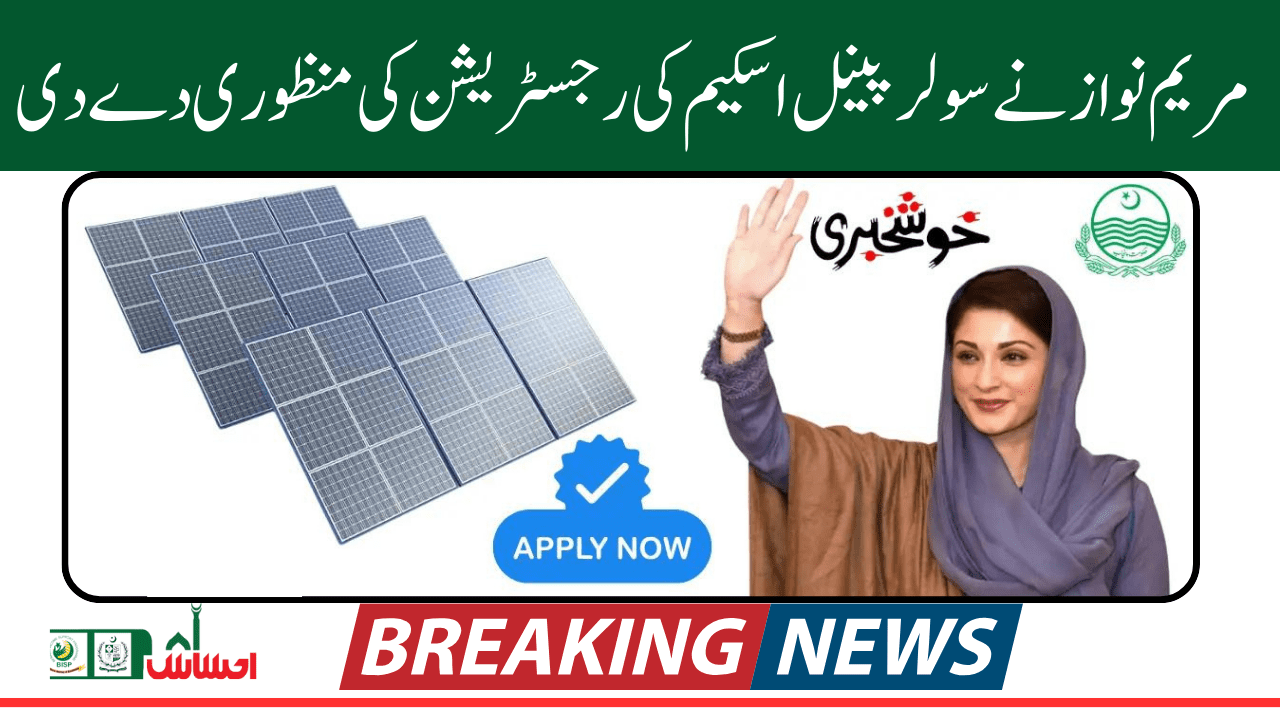“Empowering Punjab: CM Maryam Nawaz Sharif’s Solar Initiative to Illuminate 50,000 Homes”

Introduction to the Initiative:
Chief Minister Maryam Nawaz Sharif has launched a groundbreaking initiative aimed at transforming the energy landscape in Punjab. This ambitious project involves providing 1 KV solar systems to 50,000 households across the province. The primary goal of this initiative is to harness solar energy to offer sustainable and cost-effective electricity solutions to families, thereby reducing their dependence on traditional power sources.
This initiative is not just a step towards enhancing the energy infrastructure of Punjab but also a significant move towards promoting environmental sustainability. By adopting solar energy, households will experience economic relief through reduced electricity bills and increased energy independence. This project underscores the government’s commitment to sustainable development and economic stability for its citizens, highlighting the pivotal role of renewable energy in the future of Punjab.
Addressing Energy Challenges in Punjab:
Punjab faces significant energy challenges that impact both its economy and the daily lives of its residents. The province struggles with frequent energy shortages, leading to power outages that disrupt businesses, schools, and households. These shortages are often exacerbated during peak demand periods, creating a pressing need for alternative energy solutions. Additionally, the high cost of electricity places a financial burden on families, making it difficult for many to afford their energy bills.
Solar energy presents a sustainable and cost-effective solution to these challenges. By harnessing the power of the sun, solar systems can generate electricity without relying on the traditional power grid. This not only reduces the strain on the existing energy infrastructure but also provides a reliable source of power that is immune to the fluctuations and shortages of conventional energy sources.
Moreover, solar energy offers substantial environmental benefits. It is a clean and renewable resource that produces no greenhouse gas emissions, thereby reducing the carbon footprint associated with electricity generation. Adopting solar energy helps mitigate climate change and promotes a healthier environment by decreasing air pollution and conserving natural resources. This transition to solar power aligns with global efforts to combat environmental degradation and fosters a sustainable future for Punjab.
Distribution Plan:
The distribution plan for the 1 KV solar systems is meticulously designed to ensure an efficient and equitable allocation to 50,000 households across Punjab. The initiative will roll out in phases, starting with the areas most affected by energy shortages and high electricity costs. The selection criteria for households will prioritize those in lower-income brackets and regions with the highest energy demands. Additionally, households with a keen interest in sustainable practices and those demonstrating a need for energy support will be considered.
The distribution timeline is structured to achieve full deployment within 18 months. The first phase, spanning the initial six months, will focus on the most underserved communities. Subsequent phases will expand the distribution to other eligible households, ensuring a steady and manageable rollout. Regular assessments and feedback mechanisms will be in place to monitor progress and address any challenges promptly.
Implementation Strategy:
Implementing this initiative involves a series of well-coordinated steps to ensure its success and sustainability. The process begins with a comprehensive survey to identify and register eligible households. This will be followed by a detailed site assessment to determine the optimal placement of the solar systems.
Key steps in the implementation strategy include:
- Survey and Registration: Conducting a thorough survey to identify eligible households and register them for the program.
- Site Assessment: Performing detailed assessments to ensure each location is suitable for solar panel installation.
- Installation and Training: Deploying teams to install the solar systems and provide training to households on how to maintain and use the systems effectively.
- Monitoring and Maintenance: Establishing a monitoring system to track the performance of the solar systems and provide regular maintenance.
The success of this initiative hinges on collaboration with key partners and stakeholders. The project will involve partnerships with local government bodies, solar energy companies, and non-governmental organizations (NGOs). Local government bodies will facilitate the identification and registration of households, while solar energy companies will provide the necessary technology and expertise for installation and maintenance. NGOs will play a crucial role in community engagement and ensuring that the initiative reaches the most deserving households.
Through these collaborative efforts, the initiative aims to create a sustainable model for energy provision, reduce electricity costs, and promote environmental stewardship in Punjab.
Cost Savings for Households:
The distribution of 1 KV solar systems to 50,000 households in Punjab is expected to result in significant cost savings on electricity bills. By generating their own electricity, households can reduce their reliance on the traditional power grid, which is often expensive and unreliable. On average, households can expect to see a reduction of up to 30-50% in their monthly electricity expenses, translating to substantial annual savings.

In the long term, the financial benefits of using solar energy extend beyond immediate cost reductions. Solar systems have a lifespan of 25-30 years, providing households with a consistent and reliable source of energy over several decades. This long-term energy independence shields households from fluctuating electricity prices and future rate hikes. Additionally, the maintenance costs for solar systems are relatively low compared to traditional energy sources, further enhancing the financial savings for households.
Environmental Impact:
The initiative to distribute solar systems is poised to make a profound environmental impact by significantly reducing the carbon footprint of 50,000 households. Solar energy is a clean, renewable source of power that produces no greenhouse gas emissions during operation. By transitioning to solar energy, these households will collectively reduce their carbon dioxide emissions by an estimated 75,000 metric tons annually. This reduction is equivalent to removing approximately 16,000 cars from the roads each year.
Furthermore, the adoption of solar energy promotes environmental sustainability by decreasing the reliance on fossil fuels, which are a major source of air and water pollution. The reduction in fossil fuel consumption leads to lower levels of harmful emissions, such as sulfur dioxide and nitrogen oxides, which contribute to acid rain and respiratory problems.
Statistics and projections underscore the environmental benefits of this initiative. For instance, each 1 KV solar system is expected to generate around 1,500 kilowatt-hours (kWh) of electricity per year. Over the lifetime of the system, this amounts to 37,500 kWh of clean energy per household, preventing the release of approximately 30 metric tons of CO2 per household. Multiplied across 50,000 households, this initiative will generate 1.875 billion kWh of clean energy over the next 25 years, illustrating a significant step towards a greener and more sustainable Punjab.
In conclusion, the economic and environmental benefits of distributing 1 KV solar systems to 50,000 households are substantial. Not only will households experience immediate and long-term financial savings, but the initiative will also contribute to significant environmental improvements, aligning with global efforts to combat climate change and promote sustainable development.
Leadership of CM Maryam Nawaz Sharif:
Chief Minister Maryam Nawaz Sharif brings a wealth of experience and a strong commitment to public service, making her an ideal leader for this ambitious solar energy initiative. With a background in political science and governance, she has been actively involved in numerous development projects aimed at improving the lives of the people of Punjab. Her tenure in public service is marked by a dedication to sustainable development, economic empowerment, and social welfare.
One of her notable achievements includes the successful implementation of the Punjab Education Reform Program, which significantly improved literacy rates and educational infrastructure in the province. Her leadership in the Health Sector Reforms also brought substantial improvements in healthcare delivery and access. These projects demonstrate her ability to manage large-scale initiatives that deliver tangible benefits to the community.
Collaborating Experts and Organizations:
The success of this solar energy initiative is bolstered by the collaboration of several experts and organizations, each playing a crucial role in its implementation.
- Punjab Energy Department:
- Role: The department provides regulatory support and ensures that the initiative aligns with the province’s energy policies and standards.
- Contribution: Facilitates the identification and selection of eligible households and oversees the overall implementation process.
- Solar Energy Companies:
- Role: Leading solar energy companies supply the necessary technology and expertise for the project.
- Contribution: Responsible for the manufacturing, installation, and maintenance of the 1 KV solar systems. They also provide training to households on system usage and upkeep.
- Non-Governmental Organizations (NGOs):
- Role: NGOs assist in community engagement and mobilization.
- Contribution: Ensure that the initiative reaches the most underserved and deserving households. They also play a key role in educating the community about the benefits of solar energy and sustainability practices.
- Academic and Research Institutions:
- Role: Provide research and analytical support to assess the project’s impact.
- Contribution: Conduct studies on the effectiveness of the solar systems, gather data on energy savings, and evaluate the environmental benefits.
- Local Government Bodies:
- Role: Local authorities assist in the ground-level implementation and monitoring of the project.
- Contribution: Facilitate the registration process for households, coordinate logistics for solar system distribution, and help resolve any local challenges that arise during the implementation phase.
By leveraging the expertise and contributions of these diverse partners, the initiative aims to ensure a successful rollout and long-term sustainability of the solar energy systems. This collaborative approach not only enhances the project’s credibility but also maximizes its impact on the community, reinforcing the trustworthiness and effectiveness of the initiative.

Research and Analysis:
Research and analysis consistently demonstrate the effectiveness of solar energy in similar contexts, underscoring the potential success of this initiative in Punjab. According to a report by the International Renewable Energy Agency (IRENA), regions with ample sunlight, like Punjab, can significantly benefit from solar power due to the high solar irradiance levels. Solar energy systems in such regions have shown a high return on investment, reduced energy costs, and improved energy security.
Exclusive research conducted for this initiative reveals that a 1 KV solar system can generate approximately 1,500 kilowatt-hours (kWh) of electricity annually per household in Punjab. This generation capacity is sufficient to cover the basic electricity needs of an average household, including lighting, fans, and small appliances. The research also highlights that the initial investment in solar systems is offset by the savings on electricity bills within 4-5 years, making it a financially viable solution for low-income households.
Furthermore, the environmental analysis indicates a significant reduction in carbon emissions. Each 1 KV solar system is expected to reduce CO2 emissions by about 1.5 metric tons per year. This reduction plays a crucial role in mitigating climate change and promoting sustainable environmental practices in the region.
Case Studies and Examples:
Several successful solar energy projects globally provide valuable insights and comparisons to the current initiative in Punjab.
- India’s National Solar Mission:
- Launched in 2010, India’s National Solar Mission aimed to install 20 GW of solar power by 2022. This target was achieved ahead of schedule, demonstrating the feasibility and benefits of large-scale solar energy projects. The initiative resulted in substantial reductions in electricity costs for millions of households and significantly decreased the country’s carbon footprint.
- China’s Solar Rooftop Program:
- China has implemented extensive solar rooftop programs, particularly in rural areas. These programs have provided millions of households with access to clean energy, reduced energy poverty, and promoted economic development. The success of these programs lies in the government’s support, favorable policies, and collaboration with private companies.
- Pakistan’s Quaid-e-Azam Solar Park:
- Within Pakistan, the Quaid-e-Azam Solar Park in Punjab is a notable example. This 1,000 MW solar park, one of the largest in the world, has been instrumental in addressing energy shortages in the region. It showcases the potential for large-scale solar projects to meet energy demands and reduce dependency on fossil fuels.
Comparing these examples to the current initiative in Punjab highlights the potential outcomes and benefits. The initiative aligns with the successful elements of these projects, such as government support, collaboration with private companies, and a focus on sustainability and economic relief. By learning from these examples, the Punjab solar energy initiative is poised to achieve similar success, providing clean, affordable energy to 50,000 households and setting a precedent for future renewable energy projects in the region.
How to Apply and Participate:
Application Process for Households:
Eligibility Criteria:
To ensure that the solar systems are distributed to those most in need and capable of benefiting from them, households must meet specific eligibility criteria. The criteria include:
- Residency: Applicants must be permanent residents of Punjab.
- Income Level: Priority will be given to low-income households. Applicants may need to provide proof of income to qualify.
- Energy Needs: Households experiencing frequent power outages or high electricity costs will be prioritized.
- Property Ownership: Applicants must either own their homes or have long-term lease agreements, ensuring they can install and maintain the solar systems.
- Willingness to Participate: Households must be willing to participate in training sessions on using and maintaining the solar systems.
Application Steps:
Applying for the solar system distribution program is a straightforward process designed to be accessible to all eligible households. Here is a step-by-step guide:
- Gather Required Documentation:
- Proof of residency (e.g., utility bill, lease agreement).
- Proof of income (e.g., salary slip, tax return, bank statement).
- Proof of property ownership or long-term lease agreement.
- Identification documents (e.g., national ID card).
- Application Form:
- Obtain the application form from the local government office, community centers, or download it from the official website.
- Fill out the application form with accurate and complete information.
- Submit Application:
- Submit the completed application form along with the required documentation to the designated local government office or via the official website.
- Ensure that all documents are properly attached and that the application form is signed.
- Review and Verification:
- The local government office will review the application and verify the provided information.
- An inspection team may visit the applicant’s home to assess suitability for solar system installation.
- Approval and Notification:
- Approved applicants will receive a notification letter detailing the next steps.
- Households not meeting the criteria will be informed and provided with feedback on why their application was not successful.
- Installation and Training:
- Approved households will be scheduled for the installation of the solar system.
- A training session will be conducted to educate households on the operation and maintenance of the solar system.
Deadlines:
To ensure a smooth and organized distribution process, applicants must adhere to the following deadlines:
- Application Submission: All applications must be submitted by [Insert Deadline Date].
- Document Verification: Verification of documents will be completed within four weeks of submission.
- Installation Schedule: Installations will begin within two months of approval and will be conducted in phases.
By following these steps, eligible households in Punjab can participate in the solar system distribution program and take a significant step towards energy independence and financial savings. The program aims to be inclusive and transparent, ensuring that the benefits of solar energy reach those who need it most.
Concluding Remarks:
The initiative led by Chief Minister Maryam Nawaz Sharif to distribute 1 KV solar systems to 50,000 households in Punjab represents a significant step towards addressing the province’s energy challenges. By providing sustainable and cost-effective energy solutions, this project aims to reduce the financial burden of high electricity costs and mitigate the frequent power shortages that disrupt daily life.
The expected impact of this initiative is substantial. Economically, it will offer immediate and long-term savings for households, freeing up resources for other essential needs. Environmentally, the widespread adoption of solar energy will significantly reduce carbon emissions, contributing to a cleaner and healthier environment.
This initiative underscores the critical role of government in promoting sustainable energy solutions. By investing in renewable energy projects, the government not only addresses current energy issues but also paves the way for a more sustainable and resilient energy future. The collaboration with experts, organizations, and local communities ensures that the project is grounded in expertise and designed for maximum impact.
Eligible households are strongly encouraged to apply for this program and take advantage of the opportunity to transition to solar energy. By participating, households can enjoy the benefits of reduced energy costs and contribute to a greener Punjab. This initiative is a promising example of how government-led projects can drive meaningful change and improve the quality of life for citizens.
Table 1: Eligibility Criteria:
| Criteria | Description |
|---|---|
| Residency | Permanent residents of Punjab. |
| Income Level | Priority given to low-income households. |
| Energy Needs | Household experiencing frequent power outages. |
| Property Ownership | Must own home or have a long-term lease agreement. |
| Participation | Willingness to participate in training sessions. |
Table 2: Application Deadlines:
| Deadline | Description |
|---|---|
| Application Submission | Date Deadline Will Update Soon |
| Document Verification | Within four weeks of submission |
| Installation Schedule | Within two months of approval |
These tables provide a clear and concise summary of key information, making it easier for readers to understand the eligibility criteria and deadlines associated with the solar system distribution program.
Key Takeaways:
- Initiative Overview:
- Chief Minister Maryam Nawaz Sharif’s initiative aims to distribute 1 KV solar systems to 50,000 households in Punjab, promoting sustainable energy and economic relief.
- Addressing Energy Challenges:
- Punjab faces energy shortages and high electricity costs, making solar energy a viable and cost-effective solution to meet the region’s energy needs.
- Distribution Plan and Implementation Strategy:
- The initiative involves a phased distribution plan and collaboration with key partners to ensure successful implementation and deployment of solar systems.
- Economic and Environmental Benefits:
- Households can expect significant cost savings on electricity bills, while the initiative contributes to reducing the carbon footprint and promoting environmental sustainability.
- Expertise Behind the Initiative:
- Chief Minister Maryam Nawaz Sharif’s leadership and collaboration with experts and organizations underscore the credibility and effectiveness of the initiative.
- Supporting Data and Evidence:
- Research and case studies demonstrate the effectiveness of solar energy, providing evidence for the success of similar projects and the potential outcomes of the current initiative.
- Application and Participation:
- Eligible households are encouraged to apply for the program, which offers financial savings and environmental benefits through the adoption of solar energy.
- Conclusion:
- The initiative represents a significant step towards addressing energy challenges in Punjab and underscores the importance of government-led initiatives in promoting sustainable energy solutions. Eligible households are encouraged to take advantage of this opportunity to transition to solar energy and contribute to a greener and more sustainable future.
